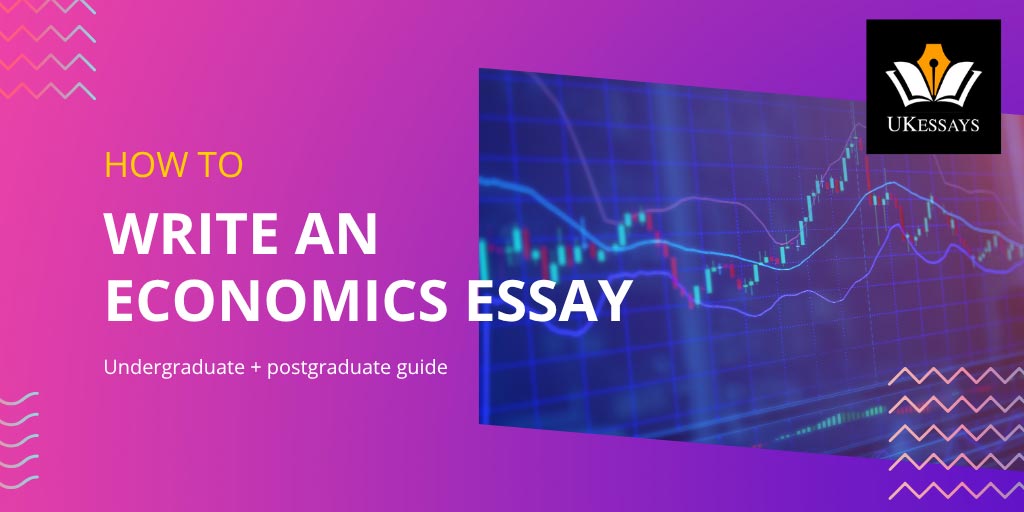How to write an economics essay
Info: 4662 words (19 pages) Study Guides
Published: 30 Jul 2025

For help from our economics team with essays, problem sets, policy briefs, econometrics, economic modelling, dissertations, or assignments involving Stata, R, SPSS, Python, Tableau, cost-benefit analysis, game theory, GIS, qualitative methods, and more, see our Economics Assignment Help page.
Economics essays are a distinct form of academic writing that require a strategic blend of theoretical understanding, factual evidence and clear argumentation. For both undergraduates and postgraduates, a high-quality economics essay requires careful analysis of the question, well-structured argumentation, and critical evaluation of ideas.
Writing such an essay involves not just generic skills but also specific approaches tailored to the economics discipline. This guide provides a comprehensive set of strategies designed for economics, helping you craft essays that are analytical, evidence-based, and coherent.
Analyse the essay question
A successful economics essay starts with a thorough analysis of the question you need to answer. Take time to unpack the question – identify the key terms and the scope of what is being asked. For example, an essay might ask “What caused the ERM crisis of 1992/3?”. In this case, you must focus on the factors behind that specific event, rather than describing unrelated currency crises from other periods (Carlin et al., 2001). Pay attention to directive words like “analyse”, “discuss” or “to what extent” because these terms indicate the approach your argument should take.
It is also important to determine whether the question relates to economic theory, a policy issue or a historical event. Each of these areas might require a slightly different focus. For instance, a theory-focused question could demand a deeper explanation of economic models. In contrast, a policy question might require evaluating real-world outcomes and trade-offs.
If any concept in the title is unclear, clarify its meaning before you proceed. Economics questions often involve specific terminology (e.g. “sustainable growth” or “market equilibrium”), so you need to be clear about definitions. By carefully dissecting the question and its underlying assumptions, you set a strong foundation for your entire essay.
Conduct thorough economic research
Once you understand the question, research widely to gather the knowledge and evidence needed to form your argument. Effective research in economics goes beyond lecture notes; it typically involves consulting textbooks for theoretical frameworks and reading academic papers or reputable economic analyses for up-to-date insights.
You should look for relevant data, case studies and examples to support your points. For instance, use historical statistics, findings from journal articles, or reports from institutions like the IMF or the Bank of England. Using high-quality sources is essential – it grounds your essay in factual evidence and lends credibility to your arguments. Avoid unreliable websites or anecdotal information. Instead, rely on established economic research and data sources.
As you research, take notes and keep track of sources for any evidence or ideas you plan to use. Economics is an evidence-based discipline, so robust data and references strengthen your essay. If the essay is about a policy issue, gather empirical studies that evaluate that policy’s impact. If it’s about an economic theory, find classic papers or economists’ writings that discuss or critique that theory.
Postgraduate students, in particular, are expected to engage critically with the literature by reading more journal articles and working papers than undergraduates. However, at all levels depth of understanding is more important than sheer quantity of sources. Focus on truly understanding the arguments and evidence you read, so that you can use them more effectively in your essay.
Develop a clear argument and outline
With a solid grasp of the material, you can form a clear thesis – the central argument or answer that your essay will put forward. A common mistake is to start writing without a definite position. Instead, explicitly decide what your answer to the question is, based on your understanding of the evidence.
Once you have a thesis, outline your essay by listing the main points that will support this argument. Each major point will likely become a section or paragraph in your essay. Ensure these points flow in a logical order that builds your overall case. The structure might be chronological (for a historical analysis), thematic, or based on a logical progression of an economic argument (such as cause and effect).
Formulate a clear thesis
Your thesis should be a direct answer to the essay question, expressed in one or two sentences. For example, if the question asks whether capital accumulation alone can ensure sustainable economic growth, your thesis might be that capital accumulation is not sufficient on its own. This is the core idea that you will argue throughout the essay. Having a clear thesis early on will guide the development of your arguments.
Outline your argument structure
Economics writing benefits from a structured approach often described as thesis – justification – support (McLean et al., 2008). In practice, for each major argument you make, you should present your statement (thesis) and explain the economic reasoning or theory behind it (justification). You should then provide evidence to support it (support). Organising your outline like this ensures that every part of your essay directly contributes to answering the question.
For example, suppose your essay question asks whether the accumulation of capital is sufficient to ensure sustainable growth in living standards. Your overall thesis might be that capital accumulation on its own is not sufficient for sustained growth. You would justify this by referencing an economic model (for example, the Solow growth model’s prediction of diminishing returns) and then support it with empirical evidence.
For instance, you might cite historical examples of heavy investment drives that did not yield proportional increases in long-term growth (Mankiw, Romer and Weil, 1992). By planning your argument in this structured way, you can be confident that each section of your essay will work together to support your thesis.
Before moving on, double-check that your outline addresses all aspects of the prompt. If the question has multiple parts (for example, “Discuss the causes and consequences of X”), ensure that your plan covers each part with appropriate balance. A clear outline serves as a roadmap. It makes the writing process more efficient and keeps your argument focused.
Write an effective introduction
The introduction of your economics essay must quickly and clearly convey to the reader what the essay will do. In the first few sentences, establish the context or relevance of the topic. For instance, if the essay is about a policy issue or an economic crisis, you might mention why this issue matters – perhaps its significance for economic stability or public welfare.
Next, state your thesis – the central answer or stance your essay will argue. This statement lets the reader know your position from the outset.
After stating your thesis, it is good practice to outline the structure of your argument in brief. In other words, preview the main points or sections that the essay will cover in support of your thesis. This guidepost helps the reader follow your reasoning. It shows that you have a logical plan.
As an example, consider an essay titled “Do trade deficits matter for long-term economic growth?”. An effective introduction might note why trade deficits remain controversial in economics (to establish context) and then clearly state a position – e.g.
“This essay argues that moderate trade deficits are not inherently harmful to long-term growth, due to factors A, B and C.”
It would then briefly indicate what each of those factors represents (for instance, linking A to a theoretical explanation, B to historical evidence, and C to recent data). By the end of such an introduction, the reader understands how you interpret the question and how you plan to answer it.
Keep the introduction concise and to the point. In economics essays, an overly broad or verbose introduction can waste words without adding value. Get to the heart of the issue quickly, and avoid sweeping generalisations. If needed, briefly define key terms to clarify how you interpret the question. For example, define what “sustainable growth” means in the context of your argument, if it’s a key term in the question. A strong introduction sets the stage for the analysis to come. It also instills confidence that your essay will be well-argued.
Craft a well-structured body with economic analysis
The main body of your essay is where you develop your argument in detail. It typically consists of several paragraphs that each make a specific point. Each paragraph should revolve around a clear topic sentence that states the point of that paragraph in relation to the essay question. For example, if you are writing about the causes of an economic phenomenon, a paragraph might start:
“One fundamental cause of the 1992 ERM crisis was the misalignment between British monetary policy and the fixed exchange rate commitment.”
This opening sentence directly signals the paragraph’s focus. Everything that follows in that paragraph should serve to explain or substantiate that statement through reasoning and evidence.
Structure your paragraphs clearly
In the main body, each paragraph should be structured to support your overall argument. Start each paragraph with a topic sentence that clearly relates to the essay question. Following the topic sentence, provide your reasoning or explanation, and then offer evidence or examples to back it up. This paragraph structure ensures clarity and cohesion.
For instance, after stating that misaligned monetary policy contributed to the ERM crisis, you would explain how the policy differed from the exchange-rate requirements, and then give evidence – perhaps data or historians’ analyses – showing that this misalignment led to pressure on the currency peg.
Use theory and evidence effectively
When writing the body, consistently apply the thesis–justification–support pattern for your arguments (McLean et al., 2008). Present your claim (the economic idea or argument), explain the logic or theory behind it, and then provide evidence or examples to support it. Use economic theory and models appropriately: if the question involves theoretical disputes, bring in the relevant models or frameworks (for example, use the IS-LM model for a macroeconomic policy question, or a supply-and-demand diagram for a market analysis).
Demonstrate that you understand the theory by explaining it in your own words and linking it to the question. However, avoid unnecessary digressions into theory that do not directly help answer the question. Stay focused on exactly what the question is asking.
In addition to theory, incorporate empirical evidence to support your arguments. This could include statistical data, historical examples or findings from empirical studies. For example, if you argue that a certain policy (like raising the minimum wage) has minimal impact on employment levels, support this claim with evidence. You might cite econometric studies or real-world cases where minimum wage hikes did not lead to higher unemployment.
Make sure to reference sources for any data or factual claims, using Harvard-style in-text citations (e.g. Smith, 2020). Using evidence not only strengthens your argument; it also shows the reader that you have engaged deeply with the material. If relevant, include diagrams or graphs to illustrate key points – for instance, an AD–AS diagram to show the effect of a demand shock, or a game theory payoff matrix for a strategic interaction.
When you use a diagram, explain it fully in the text and highlight what insight it provides for your argument. Do not assume the reader will infer the significance of a figure without your explanation. Similarly, if you use equations or specific economic symbols, define them and explain their role (Carlin et al., 2001).
Clarity is crucial: each piece of analysis or evidence you include should be explicitly tied back to the essay question, showing the reader how it supports your thesis. Throughout the body of your essay, maintain an analytical tone. Rather than just describing events or listing facts, focus on the why and how. In other words, explain the economic mechanisms at work and their implications.
For example, don’t just note that “inflation was high in country X after policy Y.” Delve into analysis by explaining whether monetary expansion caused the inflation and by discussing if that outcome fits the theory’s predictions. This approach demonstrates sound economic reasoning and shows that you are answering the question in a critical and thoughtful way.
Ensure logical flow between ideas
A well-structured economics essay often compares multiple perspectives or examines a chain of reasoning. As you move from one paragraph or point to the next, use transition words and phrases to guide the reader and maintain a logical flow. Words and phrases like “however”, “moreover”, “consequently”, “for example” and “on the other hand” signal how your next sentence or paragraph relates to the previous one.
For instance, you might write: “Expansionary fiscal policy can boost aggregate demand in the short run (supported by Keynesian theory and evidence from the 2008–09 crisis). However, it may also lead to higher debt and potential crowding out of private investment. Classical economists caution about this possibility.”
These transitions and balanced points show structured argumentation, as you systematically address different facets of the issue.
To ensure your essay flows well, check that each paragraph logically follows from the one before. You can achieve this by explicitly linking ideas. For example, if one paragraph discusses short-term effects and the next covers long-term effects, a linking sentence or phrase can highlight that shift (e.g. “In the longer term, however,…”).
Make sure that transitions between sentences and paragraphs are smooth. This will improve the overall coherence of your argument and help the reader see how each point contributes to your case.
Demonstrate critical evaluation
High-quality economics essays do not only present facts or accepted theories – they also critically evaluate the arguments and evidence. Critical evaluation means questioning assumptions, considering counter-arguments and reflecting on the strength of the evidence. This is a key skill that demonstrates a deeper understanding of the topic.
Consider alternative perspectives
One approach is to discuss alternative viewpoints. If there are multiple schools of thought about your topic, acknowledge and outline these perspectives. For instance, an essay on a macroeconomic issue might note both Keynesian and Monetarist interpretations. After presenting differing views, explain why your essay’s argument aligns more with one side. Alternatively, note how elements of each view might be valid under different conditions. This shows that you have not ignored plausible counter-arguments.
Acknowledge limitations of theories and data
Another aspect of evaluation is examining the limitations of theories or data. Economic models often rely on simplifying assumptions – mention these and consider how they affect the applicability of the theory to real life. For example, if your essay relies on the Solow growth model, note that it assumes exogenous technological progress. Explain how that assumption limits the model’s ability to predict long-term growth paths. Similarly, if you cite an empirical study, consider its scope or methodology: was it focused on a specific country or period that might not generalise? By addressing such limitations, you demonstrate depth of understanding and avoid making your argument seem one-sided or overly absolute.
Weigh costs and benefits
When evaluating policy questions, always weigh costs and benefits, or short-run versus long-run impacts. For instance, an essay on protectionist trade policy could acknowledge that tariffs may protect certain domestic industries in the short run. However, they can also lead to retaliation and efficiency losses in the long run. Showing that you can assess both sides of a policy’s impact makes your argument more nuanced and robust. Use cautious, nuanced language when appropriate. Words like “however”, “on the other hand”, “arguably” or “it is possible that…” signal that you are evaluating rather than just asserting.
Take a clear but nuanced position
Importantly, maintaining a critical tone does not mean sitting on the fence or being afraid to draw conclusions. You should still take a clear position in answer to the question, but you bolster that position by demonstrating awareness of complexities and opposing arguments. For example, you might conclude that a policy is beneficial overall only under certain conditions. Or you might find that one theory explains a phenomenon better than another given the evidence. Economic writing values precision and honesty. If evidence remains inconclusive or a theory only partially explains the facts, it is better to acknowledge that. It is worse to ignore those aspects.
Critical evaluation is often what separates a top-tier essay from an average one. It reflects an advanced understanding of the topic, which is especially expected at postgraduate level. A postgraduate essay should engage heavily with existing literature – comparing and contrasting economists’ arguments, and perhaps identifying gaps or debates in the research.
An undergraduate essay might focus more on applying taught theories correctly, but at both levels, showing some evaluation is key to a high mark. Remember that your goal is to demonstrate understanding and independent thought. You are not just compiling what others have said – you are also commenting on it, assessing it and building upon it with your own reasoning.
Write a clear and convincing conclusion
Every economics essay should end with a concise conclusion that directly answers the question in light of the analysis you have presented. In your conclusion, avoid introducing any new evidence or arguments. Instead, summarise the main points of your analysis and state how they support your overall thesis. The reader should finish the essay with a clear understanding of your answer and the justification behind it. For instance, a conclusion might begin:
“In conclusion, the evidence presented shows that trade deficits per se do not impede long-term growth. While persistent deficits can coincide with vulnerabilities (as the case of Country X exemplifies), the overall analysis suggests that other factors, such as investment and productivity, are more decisive for growth.”
This ties together the argument and reminds the reader of how you reached your answer.
Summarise and answer the question
Start your conclusion by clearly restating your answer to the essay question. This can be a reformulation of your thesis, now reinforced by the arguments you’ve made. Then, succinctly summarise how your key points support that answer. Be sure to use definitive language – the conclusion should sound confident and decisive. For example:
“Overall, the analysis indicates that X is true. We have seen that A led to B, and evidence from C and D further confirms that X holds under the given conditions.”
Such a summary reinforces the argument one more time.
Highlight broader implications
It is often effective to link your conclusion back to the broader significance of the issue, as mentioned in your introduction. Economics is a practical discipline, so you might briefly note what the implications of your findings are for policy makers, businesses or future research. For example:
“Recognising this nuanced relationship between trade deficits and growth is important for policymakers – it indicates that efforts to boost economic performance should focus on underlying productivity rather than simply targeting the trade balance.”
However, keep this part brief and grounded. Avoid grandiose statements or claims that go beyond what your essay has demonstrated.
Finally, ensure that the tone of your conclusion is confident and definitive, reflecting the arguments you have made. Even if you acknowledged uncertainties or alternative views earlier, the conclusion is your final word on the question. If the essay question is contentious and you had to take a side, reiterate why your perspective is better supported by the evidence. If the question allowed for a nuanced answer, concisely summarise that nuance (e.g. “X policy is beneficial in situation A, but not in situation B.”). A strong conclusion reinforces the coherence of your essay and gives the reader a satisfying sense of closure.
Refine your writing style and presentation
Once you have a complete draft, it is crucial to revise and refine the essay for clarity, style and correctness. Economics writing values precision and straightforwardness. Go through your essay and eliminate any waffle – unnecessary words or sentences that do not add to your argument. Each sentence should contribute something meaningful. As McCloskey (1985) advises, brevity is the soul of clarity in economic writing. Writing concisely does not mean leaving out important content. It means delivering your points in a direct and efficient manner.
Be clear and concise
Pay attention to language and tone. Use an academic yet accessible style. This means using appropriate economic terminology (for example, terms like “opportunity cost” or “elasticity” used correctly when needed) but also keeping your sentences from becoming overly convoluted. Aim for a balance between formality and readability.
One useful tip is to read your sentences aloud – if a sentence feels too long or tangled, consider splitting it into shorter ones or simplifying the phrasing. Clarity and precision are highly valued in economics, where ambiguous language can lead to misinterpretation of an argument.
Use active voice and appropriate tone
Use the active voice predominantly, as it typically makes statements clearer and more forceful. For instance, write “The model predicts X” instead of “X is predicted by the model” (Torbet, 2018). Active voice constructions help attribute actions clearly and keep the prose lively. Using first person (“I” or “we”) is acceptable in economics to clarify assumptions or to describe what your analysis will do (Torbet, 2018).
However, do this sparingly and only when appropriate in an essay context. Many economics essays can be written in third person without personal pronouns. This style often sounds more formal. Generally, avoid phrases like “I believe” or “I feel” in the body of an academic economics essay – instead of saying “I think the policy was a failure,” it’s better to say “The policy was largely unsuccessful, as evidenced by X and Y.” This keeps the focus on analysis and evidence rather than personal opinion.
Maintain an impersonal and evidence-based tone: avoid emotive language and unsubstantiated claims. By writing in a confident and objective style, you convey that your arguments are rooted in facts and logic.
Ensure coherence and flow
Make sure that transitions between ideas are smooth throughout the essay. Each paragraph should follow logically from the one before. Use connecting words to tie sentences together where needed. This will improve flow and help the reader understand the progression of your argument. Re-read your essay to check that you have guided the reader clearly – perhaps ask a friend to read it and see if they can follow the logic.
Additionally, double-check that you consistently address the essay question in each section. If you find any paragraph that seems tangential or off-topic, consider revising it or using a linking sentence to connect it back to the main argument.
Check grammar and spelling
As part of refining, ensure that your grammar and spelling are correct. Sloppy errors in spelling or grammar can distract the reader and give an impression of carelessness (Carlin et al., 2001). Proofread your essay carefully – perhaps multiple times – focusing on common issues like subject-verb agreement, proper use of economic terms, and punctuation.
It can be helpful to read the essay out loud or use a text-to-speech tool; your ear might catch mistakes that your eye misses. Also, verify that any economic units or notations are used correctly (for example, don’t confuse million with billion, or percentage points with percentages). Consistent and correct use of economic terminology will make your writing more professional and precise.
Cite sources properly
Finally, properly cite all sources and provide references. In the text, use Harvard-style citations – for example, (Smith, 2020) – whenever you draw upon someone else’s data, theory or arguments. This not only gives credit to the original authors but also strengthens your essay by showing its scholarly basis. At the end of your essay, include a reference list with full bibliographic details for each source cited.
Follow a standard format (e.g. Harvard referencing) and be consistent. Proper referencing is essential to avoid plagiarism and to allow the reader (or marker) to verify the evidence or read further into the sources. It also demonstrates that you have engaged with existing literature.
By thoroughly polishing your writing and presentation, you elevate the quality of your economics essay. It can help bring your work to a publishable standard. An essay that is well-structured, clearly written and free of errors will make a far better impression on the examiner or reader.
Adapt to undergraduate or postgraduate expectations
The core principles of writing a good economics essay apply to all levels of study, but you should be aware of the differences in expectations between undergraduate and postgraduate work.
Undergraduate expectations
Undergraduate essays are often designed to test your understanding of fundamental economic concepts and theories taught in the course. At this level, it is crucial to show that you can correctly apply models and terminology from your lectures and readings. You should still provide evidence and some evaluation, but the range of sources may be more limited to textbooks, lecture notes and a few key papers.
Clarity of explanation often takes priority. For instance, an undergraduate essay might earn high marks for clearly working through a model’s implications and directly answering the question with well-chosen examples. In short, demonstrating that you have mastered the course material and can use it to address the question is the primary goal.
Postgraduate expectations
In contrast, postgraduate essays (such as those in a Master’s programme) typically demand a deeper level of analysis and wider research. You will need to engage with more complex theories and a broader array of scholarly sources, including recent journal articles. A postgraduate essay should demonstrate critical engagement with the literature – not just summarising what different authors say, but synthesising and critiquing their arguments.
Originality of thought becomes more important: you may need to identify gaps in existing research and to formulate your own perspective on a debate, supported by evidence. For example, a postgraduate essay question might require you to evaluate an economic policy using advanced theoretical models or cross-country empirical evidence. Your essay would then need to demonstrate a command of those advanced materials.
Despite these differences in scope and depth, the effort to maintain clarity and coherence in your essay is equally vital at both levels. Both undergraduates and postgraduates should answer the question fully, back up claims with evidence, and write in a logical, professional manner. The distinction lies mainly in the breadth of reading and the level of critical insight expected.
If you transition from undergraduate to postgraduate study, prepare to invest more time in reading and to develop more nuanced arguments. Nonetheless, by adhering to solid essay-writing practices – analysing the question, structuring your argument, writing clearly and evaluating critically – you will meet the expectations of any academic level.
Final thoughts
Writing an economics essay is a process that combines rigorous thinking with clear communication. By carefully analysing the question, conducting focused research and building a structured argument, you will address the topic in a way that showcases your economic understanding. Always remember to evaluate critically – economics is full of debates and conditional conclusions, so acknowledging complexity can enhance the credibility of your essay.
Pay attention to writing style, because how you present your argument can be just as important as the argument itself. A well-written essay that is cogent, evidence-rich and analytically sharp will stand out to examiners, demonstrating your skills as an economist in training. By following the guidance in this comprehensive approach, you can confidently tackle economics essay assignments at any level. This approach will help you produce work that is academically rigorous yet engaging to read.
For help from our economics team with essays, problem sets, policy briefs, econometrics, economic modelling, dissertations, or assignments and more, see our Economics Assignment Help page.
References and further reading:
- Carlin, W., Lemos, S., Lilico, A., & Rau, N. (2001) Writing a coursework essay – notes for undergraduate economics students. University College London (UCL Economics Department).
- McCloskey, D. N. (1985) Economical Writing. Economic Inquiry, 23(2), pp. 187–222.
- McLean, N., Bray, M., & Lawrence, S. (2008) Writing for Economics (online tutorial). The Economics Network, London School of Economics and Political Science.
- Mankiw, N. G., Romer, D., & Weil, D. N. (1992) ‘A Contribution to the Empirics of Economic Growth’, Quarterly Journal of Economics, 107(2), pp. 407–437.
- Torbet, G. (2018) ‘Top Writing Tips For Economics Papers’. INOMICS, 1 March 2018. Available at: https://inomics.com/advice/top-writing-tips-for-economics-papers-1141763.
Cite This Work
To export a reference to this article please select a referencing stye below:



